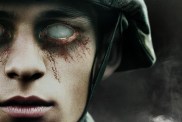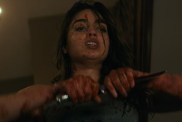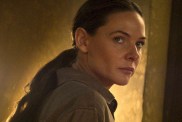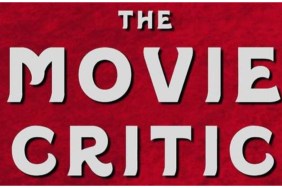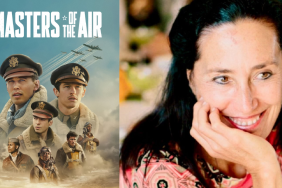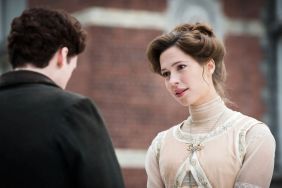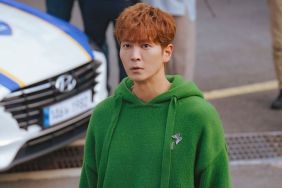We’ve already spoken to Matt Damon and John Krasinski, co-writers and stars of the upcoming drama Promised Land, as well as their co-star Rosemarie DeWitt. This means the last piece of the equation is director Gus Van Sant, who famously directed Damon’s first Oscar-winning screenplay Good Will Hunting 15 years ago.
Promised Land has a surprisingly similar feel as the duo’s earlier collaboration with Damon playing Steve Butler, a corporate salesman for a natural gas company who along with his partner (Frances McDormand) is trying to convince the folks of a small town to lease their land for drilling. Things are going well until John Krasinski’s Dustin shows up, an environmentalist who will do anything possible to convince the locals not to trust Steve and his partner.
It’s a film that’s already proving to be fairly divisive due to the attempt to create a light drama with a heavy political message behind it, although it’s clearly another step forward in the filmmaking relationship between Damon and Van Sant with Krasinski tempering what they’ve previous done with a lighter tone.
ComingSoon.net sat down with Van Sant for this quick chat at the movie’s New York junket in early December.
ComingSoon.net: I heard the story about how Matt texted you.
Gus Van Sant: Yeah, it was an email, I think or whatever, it was probably a text. I knew what it was because I’d been following the notion that he was developing something. At one time I thought he wanted Ben (Affleck) to be in it. I can’t remember. Maybe there was another project, a different project but I thought was there was a screenplay, I didn’t know what it was about, that Matt was going to direct and Ben was going to be his actor, and that’s all I knew.
CS: Maybe that was something different, but I do remember something about that as well.
Van Sant: When he called I thought that was the same project. It was the one that he was going to direct. Because “Good Will Hunting” was all of our sort of origins in some ways, especially for them, but for me as more of a mainstream director I would say. I had non-mainstream cred already, but I always thought it was going to be something that I thought, “Well, maybe they’re going to need help. Maybe something’s going to go wrong.” Something did go wrong, so this was the text. I was like, “Holy sh*t. I’m actually getting offered the thing that I was wondering whether they would need somebody to help with.” Because I had read the press, I realized this was the thing, so I was kind of ready to say yes without even reading it, but then I did read it.
CS: So when you read it, what was the first thing that struck you, either something that interested you or something you might see as a challenge?
Van Sant: It’s still hard, even as a viewer, but it was always something that we worked on from the beginning, because there’s a few contrived things in the movie, but it does happen in Capra movies and he does it very well. I think we used Capra, at least I did, as a way to sort of figure out how the characters change, and specifically Steve, Matt’s character. In Capra movies, it’s usually they’re naïve to begin with–whether it’s “Meet John Doe” or it’s “Mr. Smith Goes to Washington”–they’re just sort of guys that aren’t really thinking about this new situation they’re put in, or “Sergeant York,” which wasn’t Capra, but Jimmy Stewart. They’re guys that go into a situation where all this graft is happening and bad stuff is happening, then they’re moved to say “This shouldn’t be this way. This is our government. This is Washington, and the things I see going on around me” – there’s this point where they make a stand, and they’ve moved to make that statement. Ours was more that the guy is sort of on the side of the oil companies. He’s working for the oil companies and he makes this change. He’s not an innocent in the same way as a Capra movie, but he’s put in the middle of something that he learns about and then reacts to. He is a salesman, and so, his job is to sell, but I think in watching the machinery of his own company, in the story, it was obvious he loses heart, and that was the thing that was always like, “Why does he lose heart? What exactly goes on that makes him lose heart? What things does he think make him feel that way, feel like his heart has been lost?” That was the biggest part. It was from the very beginning and through the making. The reason it was hard, I think, was because maybe he wasn’t as much of an innocent as in a Capra movie, but it happens fast. It’s hard for people to change that quickly, you know? They might quit a job, but they don’t necessarily change their mind.

CS: I’m glad you mention that because there is such an interesting grey area to all the characters in the movie in terms of who to root for. John plays an activist, and he means well and he’s there to help people, but he plays the character almost like a bad guy to Matt’s character.
Van Sant: Yeah, which I thought was really fun because when I read the script, the Richards character and the Frank character and the Dustin character, the environmentalist, they were all people that were making Steve’s life harder, making his job harder. Since Steve was your hero, they were the railroad ties thrown into his way that he has to get over and provide the conflict of the story. They were really fun and healthy conflicting characters for his character. I think they’re kind of the reverse of maybe the way we could’ve done the story, which was like from the point of view of one of the other characters, say Frank’s character or whatever, which I liked. I liked that it was coming from the oil company’s point of view.
CS: Rosemaire also plays an interesting character, because Alice is the center of what’s almost an ecological love triangle, plus she acts as the viewer in both John and Matt have to convince her of their side of things. When I spoke to her earlier, she mentioned it was hard for her to envision what the movie would be like from the script, so was that the case with you as well? Did you know immediately what it had to look like with things like the sweeping shots of the countryside? Is that stuff you envisioned right away?
Van Sant: I think you envision it when you’re reading the screenplay, but we had to add it in. I think there was a journey that Frank made in the truck that was always the way that you saw the countryside where they lived. Some of the things were happening outdoors, so you were going to see what was going on. We added a few more things via traveling and helicopter shots and stuff, but we wanted to see the actual land itself because that was what was at risk.
CS: When you were location scouting, were you in a helicopter and you could see what that area out of Pittsburgh offered?
Van Sant: No, I didn’t scout it that way, but we did scout a week before we ended. We added the helicopter shot just because I thought we might be able to use it. We did have this weekend where we scouted and the final day of shooting was the execution of what we had scouted. But helicopters, it’s kind of easy to make them look fun, the bird’s eye views of things, but yeah, I liked that area outside of Pittsburgh. It just seemed very beautiful with a lot of old barns.
CS: That stuff must really influence the making of the movie since it sets things up and it all takes place in this environment. It’s not bouncing between different types of locations.
Van Sant: Yeah, it’s just there.
CS: By the way, Rosemarie also mentioned you didn’t even do a table read and had just one day of rehearsals before shooting.
Van Sant: Oh, we did have a table read, yeah.
CS: Oh, you did? Oh, okay. Maybe Rosemarie wasn’t there.
Van Sant: Yeah, she was probably in LA. We had it in New York, and it was specifically for script questions, and it was largely more for the executives than it was for us. I think that because John and Matt live in this actually quite fun world of thespians and because both John and Matt know musical theater people, a table read is like, “Oh yeah, we’ll just call Jimmy and John and Sue.” So it happened like in a second.
CS: So it wasn’t necessarily with actors who appear in the movie?
Van Sant: I think it was more just to hear it read aloud, you know? I think we were even going to do it with just three people, but then John like said, “No, no, let’s get” – so Billy Crudup was playing a couple of roles. There were a few…

CS: But other than that, there wasn’t any sort of rehearsal period?
Van Sant: Let’s see. Well, there wasn’t a lot of rehearsal, no, but there was like a week or so, yeah.
CS: As a director, coming into a project like this where it’s obviously John and Matt’s baby–they spent a lot of time writing and developing it–versus doing a project you’ve developed from scratch, is that something you enjoy doing? Just coming in to direct?
Van Sant: You know, I don’t have a problem doing that. When there’s a writer that has written before me or even if there’s a writer that’s written for you, there is a way that you have to re-envision (it), because the writer has something in mind, and hopefully your vision is something that they go along with. In this case, John was very excited in general about all of the stuff that we were doing. There have been times where the writer has very specific things and it’s hard for them to – part of what I do, even with my own writing, is kind of destroy the scene so that you can remake it. So if you have a very strong intention about a character, to make them alive, it’s good, for me at least, to cast somebody that’s not the character that you have in mind because it starts to become archetypes and it starts to become too by the book. But it’s good for me to just sort of re-imagine the character even in the casting process and cast somebody that wasn’t the typical answer. If the guy is supposed to be a certain ethnicity, change the ethnicity for this character when you’re casting it just so that it has some life of its own. It’s not a color by numbers, you know? “Good Will Hunting” was color by numbers (chuckles), it starts there. The script just says what to do, you just do it, and then it’ll work because it works on the page. Just sort of transfer it onto the screen. “Good Will Hunting” is much more like that than some other films that I’ve made.
CS: What about with “Milk?”
Van Sant: Yeah, it was (Dustin Lance Black’s) screenplay that I got connected to. Because of that world being such a real world, they were real people that you were casting, it was already so difficult to keep up with the way that people were in real life. Although fortunately, they weren’t super well-known, but it’s almost like primary colors. You’re casting people that are well-known people. In our cast of “Milk,” you had Harvey, who was very recognizable and a character. Because of all that stuff, the quote-unquote color-by-numbers quality, you already were lost because the character were never going to mute the real people, and there was a documentary that had the real people in it. You were never going to be able to literally take those people. There was never going to be a real Harvey. It was going to be a person playing Harvey and the same with every other character. All the other characters were really important too like Moscone or Dan White, they’re really super important, but you’re never going to literally get them. You can get close. That’s why it’s good to sort of breathe new life because since you’re never going to literally get all the way to George Moscone, that you need to have leeway to sort of make it live.
CS: How often do you revisit older movies you directed? I realized that it’s going to be 25 years since “Drugstore Cowboy” in just a couple years
Van Sant: Oh really?
CS: Do you revisit these movies when they do Blu-ray releases or anything like that?
Van Sant: I haven’t done that for that movie and I haven’t seen that movie in a while. The last time I saw that movie, it was interesting how much the movie is about a hex. You know, when we were shooting it, I mean, I think it was always part of the scenes and the nature of the scenes were always centered around a hex, but I forgot how much. It was literally like, it might as well be called “The Hex” rather than “Drugstore Cowboy.”
CS: I haven’t seen it in a while either, but I do love it.
Van Sant: When you see it, you might notice that. But I mean, it’s the kind of thing that holds the whole thing together. It is the sort of main concern of Matt’s character.
Promised Land opens nationwide on Friday, January 4.
